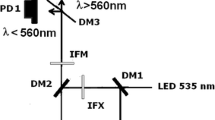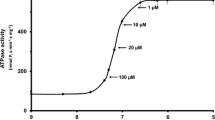Abstract
Creatine kinase (CK) (E.C. 2.7.3.2) buffers cellular ATP concentration during fluctuating ATP turnover. Muscle cytosolic CK isoform interacts with various subcellular structures where it is functionally coupled with relevant ATPases. However, how this interaction affects its activity is not known. We have therefore studied the interaction of CK with myofibrils and the role of different conformational states of CK molecule induced by ATP, phosphocreatine, ADP and the ATP-creatine pair. Purified rabbit psoas myofibrils with CK specific activity of 0.4 ± 0.02 IU/mg were used. The exchange rates between the myofibrillar M-band and its surroundings were measured with fluorofore conjugated CK (IAF) by the Fluorescence Lost in Photobleaching (FLIP) method within a very narrow pH range 7.1–7.15. For CK-IAF without docked substrates, the time derivative of the initial loss of the fluorescent signal within the M-band equalled −3.26 at the fifth second and the decrease reached 82% by the 67th second. For CK-IAF with added substrates, the derivatives fell into the range of −0.95 to −1.30, with respective decreases from 16 to 46% at the 67th second. The results show that the substrates slowed down the exchange rate. This indicates that the strength of the bond between CK and the M-band of myofibrils increased.





Similar content being viewed by others
References
Saks VA, Ventura-Clapier R, Aliev MK (1996) Metabolic control and metabolic capacity: two aspects of creatine kinase functioning in the cell. Biochim Biophys Acta 1274:81–88
Ventura-Clapier R, Veksler J, Hoerter JA (1994) Myofibrillar creatine kinase and cardiac contraction. Mol Cell Biochem 133/134:125–144
Mejsnar JA, Sopko B, Gregor M (2002) Myofibrillar creatine kinase activity inferred from a 3D model. Physiol Res 51(1):35–41
Mejsnar JA, Herman P, Malacova D et al (2005) The substrate-dependent three conformations of muscle creatine kinase. Physiol Res 54:33P
Wallimann T, Wyss M, Brdiczka D et al (1992) Intracellular compartmentation, structure and function of creatine kinase isoenzymes in tissues with high and fluctuating energy demands: the ‘phosphocreatine circuit’ for cellular energy homeostasis. Biochem J 281(1):21–40
Stolz MT, Wallimann T (1998) Myofibrillar interaction of cytosolic creatine kinase (CK) isoenzymes: allocation of N-terminal binding epitope in MM-CK and BB-CK. J Cell Sci 111(9):1207–1216
Hornemann T, Stolz M, Wallimann T (2000) Isoenzyme-specific interaction of muscle-type creatine kinase with the sarcomeric M-band is mediated by NH(2)-terminal lysine charge-clamps. J Cell Biol 149(6):1225–1234
Hornemann T, Kempa S, Himmel M et al (2003) Muscle-type creatine kinase interacts with central domains of the M-band proteins myomesin and M-protein. J Mol Biol 332(4):877–887
Kraft T, Messerli M, Rothen-Rutishauser B et al (1995) Equilibration and exchange of fluorescently labeled molecules in skinned skeletal muscle fibers visualized by confocal microscopy. Biophys J 69(4):1246–1258
Prigogine I (1967) Introduction to thermodynamics of irreversible processes. Interscience Publishers, New York, London, Sydney, pp 83–85
Gregor M, Kubala M, Amler E et al (2003) Frequency-domain lifetime fluorometry of double-labeled creatine kinase. Physiol Res 52(5):579–585
Wallimann T, Schlosser T, Eppenberger HM (1984) Function of M-band-bound creatine kinase as intramyofibrillar ATP regenerator at the receiving end of the phosphorylcreatine shuttle in muscle. J Biol Chem 259(8):5238–5246
Gregor M, Janovska A, Stefl B et al (2003) Substrate channelling in a creatine kinase system of rat skeletal muscle under various pH conditions. Exp Physiol 88(1):1–6
Solaro RJ, Pang DC, Briggs FN (1971) The purification of cardiac myofibrils with Triton X-100. Biochim Biophys Acta 245:259–262
Ventura-Clapier R, Saks VA, Vassort G et al (1987) Reversible MM-creatine kinase binding to cardiac myofibrils. Am J Physiol Cell Physiol 253:C444–C455
Blum M, Beier H, Gross MJ (1987) Improved silver staining of plan proteins, RNA and DNA in polyacrylamide gels. Electrophoresis 8(2):93–99
Stefl B, Mejsnar JA, Janovska A (1999) Energy metabolism of rat skeletal muscle modulated by the rate of perfusion flow. Exp Physiol 84:651–663
Gerhardt W (1983) Phosphotransferases: creatine kinase. In: Bergmeyer HU (ed) Methods of Enzymatic Analysis, vol. III. 3rd edn, Verlag Chemie, Weinheim, pp 508–518
Wahlefeld AW, Siedel J (1985) Metabolites 3: lipids, amino acid related compounds: creatinine and creatine. In: Bergmeyer HU (ed) Methods of enzymatic analysis, vol. VIII. 3rd edn, Verlag Chemie, Weinheim, pp 488–507
Lange S, Auerbach D, McLoughlin P et al (2002) Subcellular targeting of metabolic enzymes to titin in heart muscle may be mediated by DRAL/FHL-2. J Cell Sci 115(24):4925–4936
Lange S, Agarkova D, Perriard JC et al (2005) The sarcomeric M-band during development and disease. J Muscle Res Cell Motil 26(6–8):375–379
Adams GR, Foley JM, Meyer RA (1990) Muscle buffer capacity estimated from pH changes during rest-to-work transitions. J Appl Physiol 69:968–972
Chase PB, Kushmerick MJ (1988) Effect of pH on contraction of rabbit fast and slow skeletal muscle fibers. Biophys J 53:935–946
Malacova D, Zurmanova J, Mejsnar J (2004) Three isoelectric points of the creatine kinase M-subunit, purified from myofibrils. Physiol Res 53:22P
Wright-Weber B, Held BC, Brown A et al (2006) Immunological and physical comparison of monomeric and dimeric phosphagen kinases: some evolutionary implications. Biochim Biophys Acta 1760(3):364–371
Stolz M, Hornemann T, Schlattner U et al (2002) Mutation of conserved active-site threonine residues in creatine kinase affects autophosphorylation and enzyme kinetics. Biochem J 363: 785–792
Satyajit SM, Boyd D, Haley E (1999) ATP Nucleotidylation of creatine kinase. Biochemistry 38:8492–8500
Lahiri SD, Wang PF, Babbitt PC et al (2002) The 2.1 Å structure of Torpedo californica creatine kinase complexed with the ADP-Mg2+-NO3-creatine transition-state analogue complex. Biochemistry 41(47):13861–13867
Acknowledgements
Authors would like to thank Dr. Marta Novotova and Dr.Tomas Soukup for critical reading and valuable comments during preparation of the manuscript. This study was supported by Myores No 511978 and GACR 304/05/0327grants and by the Research project AV0Z 50110509.
Author information
Authors and Affiliations
Corresponding author
Rights and permissions
About this article
Cite this article
Zurmanova, J., Difato, F., Malacova, D. et al. Creatine kinase binds more firmly to the M-band of rabbit skeletal muscle myofibrils in the presence of its substrates. Mol Cell Biochem 305, 55–61 (2007). https://doi.org/10.1007/s11010-007-9527-1
Received:
Accepted:
Published:
Issue Date:
DOI: https://doi.org/10.1007/s11010-007-9527-1




